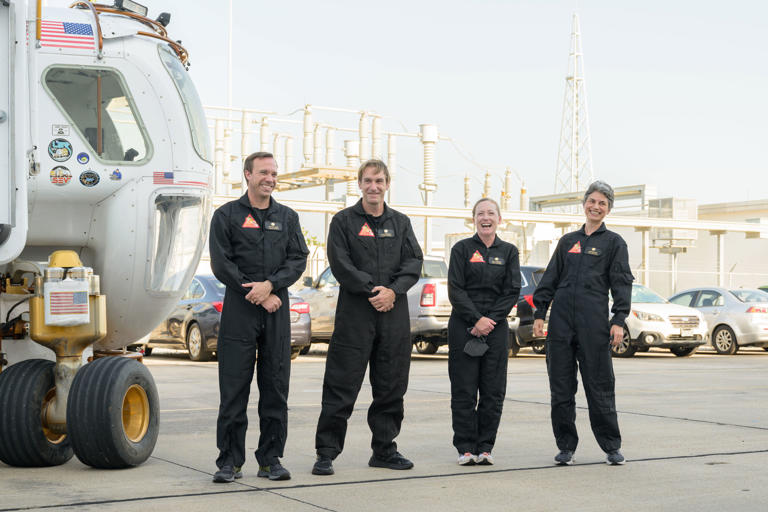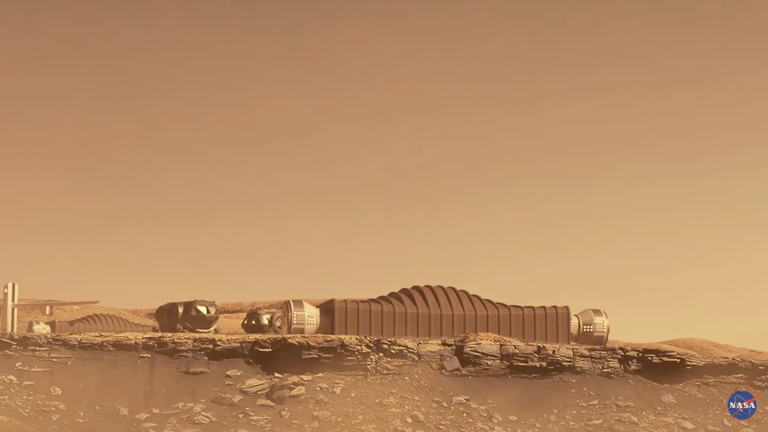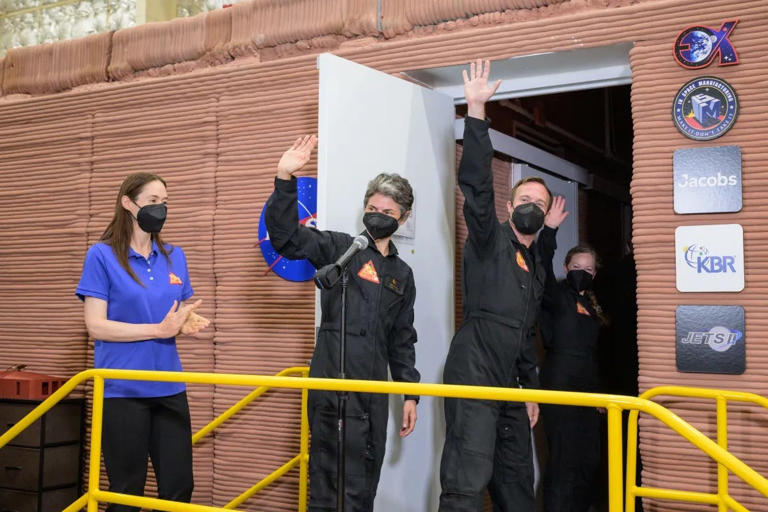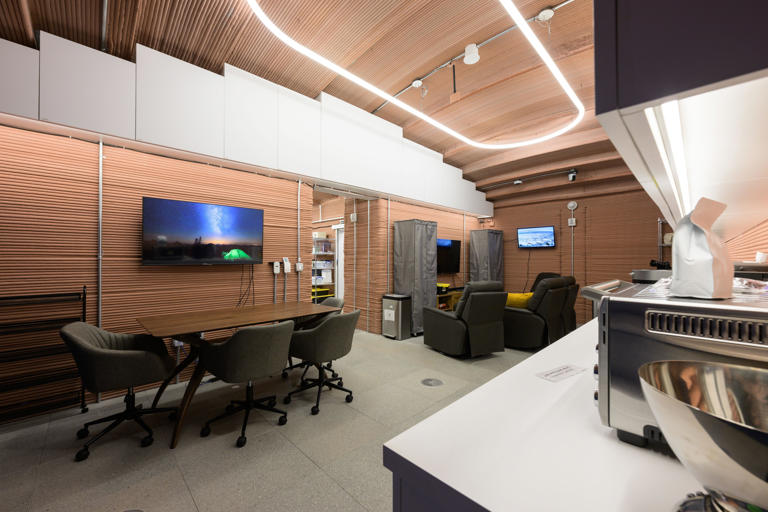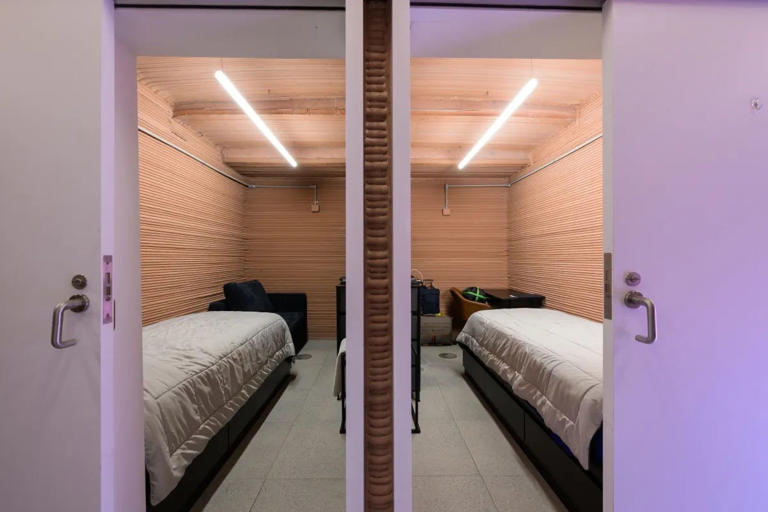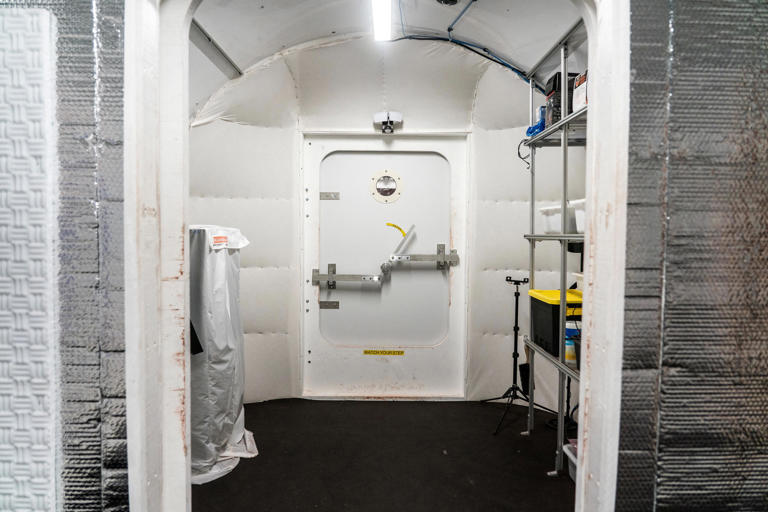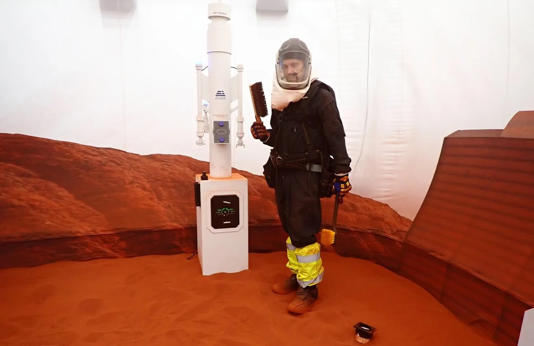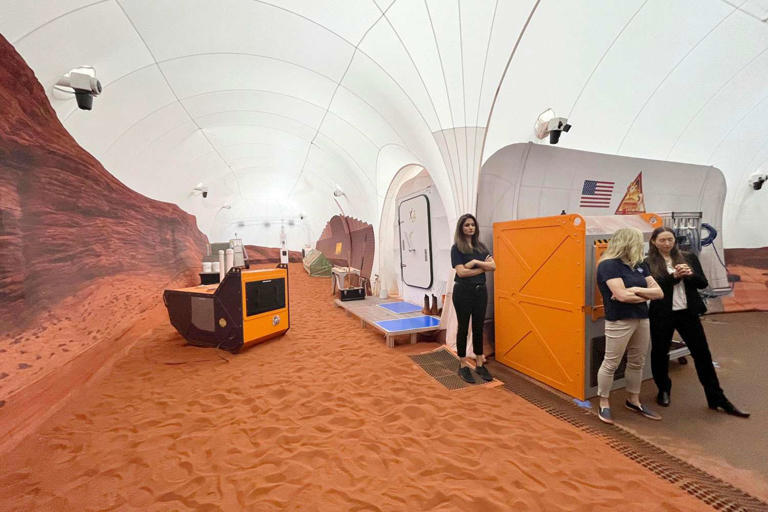New Mars Forums
You are not logged in.
- Topics: Active | Unanswered
Announcement
#1 2024-02-16 20:00:09
- SpaceNut
- Administrator
- From: New Hampshire
- Registered: 2004-07-22
- Posts: 29,932
NASA's simulated yearlong Mars mission
Martians wanted: Apply here now for NASA's simulated yearlong Mars mission
https://www.nasa.gov/humans-in-space/chapea/
NASA is seeking applicants to participate in its next simulated one-year Mars surface mission to help inform the agency's plans for human exploration of the Red Planet. The second of three planned ground-based missions called CHAPEA (Crew Health and Performance Exploration Analog) is scheduled to kick off in spring 2025.
Each CHAPEA mission involves a four-person volunteer crew living and working inside a 1,700-square-foot, 3D-printed habitat based at NASA's Johnson Space Center in Houston. The habitat, called the Mars Dune Alpha, simulates the challenges of a mission on Mars, including resource limitations, equipment failures, communication delays, and other environmental stressors. Crew tasks include simulated spacewalks, robotic operations, habitat maintenance, exercise, and crop growth.
NASA is looking for healthy, motivated U.S. citizens or permanent residents who are non-smokers, 30-55 years old, and proficient in English for effective communication between crewmates and mission control. Applicants should have a strong desire for unique, rewarding adventures and an interest in contributing to NASA's work to prepare for the first human journey to Mars.
The deadline for applicants is Tuesday, April 2.
Crew selection will follow additional standard NASA criteria for astronaut candidate applicants. A master's degree in a STEM field such as engineering, mathematics, or biological, physical, or computer science from an accredited institution with at least two years of professional STEM experience or a minimum of one thousand hours piloting an aircraft is required.
Candidates who have completed two years of work toward a doctoral program in science, technology, engineering, and mathematics, completed a medical degree, or a test pilot program will also be considered. With four years of professional experience, applicants who have completed military officer training or a bachelor of science degree in a STEM field may be considered.
Compensation for participating in the mission is available. More information will be provided during the candidate screening process.As NASA works to establish a long-term presence for scientific discovery and exploration on the moon through the Artemis campaign, CHAPEA missions provide important scientific data to validate systems and develop solutions for future missions to the Red Planet. With the first CHAPEA crew more than halfway through their yearlong mission, NASA is using research gained through the simulated missions to help inform crew health and performance support during Mars expeditions.
Under NASA's Artemis campaign, the agency will establish the foundation for long-term scientific exploration on the moon, land the first woman, first person of color, and its first international partner astronaut on the lunar surface, and prepare for human expeditions to Mars for the benefit of all.
More information: Signup page: chapea.nasa.gov/
Sounds like if I were single, I would like to do this.
Offline
Like button can go here
#2 2024-02-16 20:04:51
- SpaceNut
- Administrator
- From: New Hampshire
- Registered: 2004-07-22
- Posts: 29,932
Re: NASA's simulated yearlong Mars mission
Join NASA’s Simulated Mars Mission: A Yearlong Experiment in the Mars Dune Alpha
For a unique opportunity to aid the future of space exploration, NASA is calling for volunteers to take part in their one-year simulated Mars mission. This campaign is a crucial component of the CHAPEA (Crew Health and Performance Exploration Analog) series, with the second mission commencing in the spring of 2025.
n this hands-on experience, a team of four will live and work in a 1,700-square-foot habitat founded at the Johnson Space Center, designed to mimic the Mars environment. The module, known as Mars Dune Alpha, poses real-life challenges faced on Mars, such as limited resources, equipment breakdowns, delayed communications, and stress induced by the environment. The crew’s responsibilities include conducting simulated spacewalks, managing robotics, handling habitat upkeep, physical training, and tending crops.
Criteria for application include being a dedicated non-smoker, aged between 30 and 55, with U.S. citizenship or permanent residency status, and fluent in English for optimal interactions with the team and mission control. Ideal candidates will have a keen sense of adventure and a desire to contribute to preparations for humanity’s first mission to Mars.
The application cutoff is Tuesday, April 2.
Further astronaut-like requirements are in place for the crew selection, including a Master’s degree in a STEM field and professional experience. Those with substantial education or experience in specialized domains like doctorates, medical degrees, or test pilot backgrounds are also encouraged to apply. Monetary compensation is offered, with details provided during candidate evaluations.
This endeavor is part of NASA’s Artemis campaign, aiming to secure a sustainable human presence on the Moon as a prelude to Mars expeditions. Insights from the first CHAPEA crew, who are currently undergoing their mission, are integral in developing systems and resolving issues related to human health and performance on Mars journeys.Artemis is not solely about lunar exploration but also about laying groundwork for diverse and international crewed missions with sights set on Martian soil, signifying a monumental leap for humanity.
Offline
Like button can go here
#3 2024-02-16 20:05:38
- SpaceNut
- Administrator
- From: New Hampshire
- Registered: 2004-07-22
- Posts: 29,932
Re: NASA's simulated yearlong Mars mission
Contact Information:
Rachel Kraft (Headquarters, Washington) – rachel.h.kraft@nasa.gov
Anna Schneider/Laura Sorto (Johnson Space Center, Houston) – anna.c.schneider@nasa.gov/laura.g.sorto@nasa.gov
FAQ Section
How do I apply for the NASA simulated Mars mission?
Interested applicants can apply for the simulated Mars mission by visiting this link. Ensure you meet all the listed criteria before applying.What are the qualifications needed to participate in the mission?
Applicants should have a master’s degree in a STEM field and professional experience in related areas. Those with advanced degrees or experience such as a medical degree or a test pilot program will also be considered.When is the application deadline for the mission?
The deadline to apply for the NASA simulated Mars mission is Tuesday, April 2.Is there any compensation for participating in the mission?
Participants will be compensated, and more details will be provided during the selection process.What is the purpose of NASA’s CHAPEA missions?
CHAPEA missions are designed to collect scientific data to help NASA prepare for human expeditions to the Martian surface. They replicate the Martian environment to test crew health and performance.Conclusion
NASA’s search for candidates for the yearlong simulated Mars mission under the CHAPEA banner represents a significant stride in preparing for the human exploration of the Red Planet. This analog mission is not just an adventure; it’s a calling for those who wish to be pioneers in space travel and contribute to a future where humans step foot on Mars. As the Artemis campaign progresses, endeavors such as these will become the backbone of interplanetary expedition knowledge. This chance to participate in a Mars simulation could be the first step in a larger journey for the selected individuals, as well as for humankind.
Offline
Like button can go here
#4 2024-02-16 20:11:38
- SpaceNut
- Administrator
- From: New Hampshire
- Registered: 2004-07-22
- Posts: 29,932
Re: NASA's simulated yearlong Mars mission
How to apply for NASA's next Mars habitat simulation
See if you qualify to be a volunteer for a yearlong stint.
Looking for a change of pace from your day-to-day routine? Life on Earth feeling a bit overwhelming at the moment? How about a one-year residency alongside three strangers at a 3D-printed Mars habitat simulation?
On Friday, NASA announced it is now accepting applications for the second of three missions in its ongoing Crew Health and Performance Analog (CHAPEA) experiment. For 12 months, a quartet of volunteers will reside within Mars Dune Alpha, a 1,700-square-foot residence based at the Johnson Space Center in Houston, Texas, where they can expect to experience “resource limitations, equipment failures, communication delays, and other environmental stressors.”
When not pretending to fight for your survival on a harsh, barren Martian landscape, CHAPEA team members will also conduct virtual reality spacewalk simulations, perform routine maintenance on the Mars Dune Alpha structure itself, oversee robotic operations, and grown their own crops, all while staying in shape through regular exercise regimens.
But if the thought of pretending to reside 300 million miles away from your current home sounds appealing, well… cool your jets. NASA makes it clear that there are a few requirements applicants must meet before being considered for the jobs—such as a master’s degree in a STEM field like engineering, computer science, or mathematics. Then you’ll need either two years professional experience in a related field, or a minimum of 1,000 hours spent piloting aircrafts. Also, only non-smokers between 30 and 55-years-old will be considered, and military experience certainly sounds like a plus.
Oh, and you’ll also need to fill out NASA’s lengthy questionnaire, which includes entries like, “Are you willing to have no communication outside of your crew without a minimum time delay of 20 minutes for extended periods (up to one year)?” and, “Are you willing to consume processed, shelf-stable spaceflight foods for a year with no input into the menu?”
It’s certainly a lot to consider. But as tough as it might be, simulations like CHAPEA are vital for NASA’s Artemis plans to establish a permanent human presence on both the moon and Mars. The truly intrepid and accomplished among you have until April 2 to fill out the official application. Seeing as how CHAPEA’s inaugural class is currently about halfway through their one-year stint, this second round of volunteers won’t need to report for duty until sometime in 2025.
Offline
Like button can go here
#5 2024-02-16 20:30:40
- SpaceNut
- Administrator
- From: New Hampshire
- Registered: 2004-07-22
- Posts: 29,932
Re: NASA's simulated yearlong Mars mission
NASA opens rare job opportunity to live in a Mars simulation for a year
The Crew Health and Performance Exploration Analog (CHAPEA) is running a series of one-year "missions" where volunteers who can act as astronauts would in space — NASA calls them analog astronauts — live inside a 3D printed habitat in Houston, Texas.
The 1,700-square-foot space, called the Mars Dune Alpha, mimics the habitats NASA may one day build on Mars to shelter astronauts.
The program's first four-person crew has been living in the structure since last July. NASA's reports on their progress hint at what the job is like: growing vegetables, simulating "Marswalks" in a sandbox, overseeing science experiments like those done on the International Space Station, and following a strict exercise regimen.
Applicants must also pass a criminal background check, psychiatric screening, and a medical evaluation to be eligible. After all, they're signing up for a year of extreme isolation in close quarters with three other people and a highly regimented schedule.
Offline
Like button can go here
#6 2024-02-17 12:51:09
- SpaceNut
- Administrator
- From: New Hampshire
- Registered: 2004-07-22
- Posts: 29,932
Re: NASA's simulated yearlong Mars mission
Lots to do on this mission
NASA is looking for volunteers to live in its Mars simulation for a year
If extreme challenges are your cup of tea, NASA has the perfect opportunity for you. The space agency put out a call on Friday for volunteers to participate in its second yearlong simulated Mars mission, the Crew Health and Performance Exploration Analog (CHAPEA 2). For the duration of the mission, which will start in spring 2025, the four selected crew members will be housed in a 1,700-square-foot 3D-printed habitat in Houston. NASA is accepting applications on the CHAPEA website from now through April 2. It’s a paid gig, but NASA hasn’t publicly said how much participants will be compensated.
Nathan Jones stands inside the simulated Mars environment in a 1200-square-foot sandbox attached to the 3D printed habitat
The Mars Dune Alpha habitat at NASA’s Johnson Space Center is designed to simulate what life might be like for future explorers on the red planet, where the environment is harsh and resources will be limited. There’s a crew currently living and working there as part of the first CHAPEA mission, which is now more than halfway through its 378-day assignment. During their stay, volunteers will perform habitat maintenance and grow crops, among other tasks. The habitat also has a 1,200-square-foot sandbox attached to it for simulated spacewalks.
To be considered, applicants must be a US citizen aged 30-55, speak English proficiently and have a master’s degree in a STEM field, plus at least two years of professional experience, a minimum of one thousand hours piloting an aircraft or two years of work toward a STEM doctoral program. Certain types of professional experience may allow applicants without a master’s to qualify too. CHAPEA 2 is the second of three mission NASA has planned for the program, the first of which began on June 25, 2023.
Ok that does it I am too old to get in with the fun.
Offline
Like button can go here
#7 2024-02-25 15:11:42
- SpaceNut
- Administrator
- From: New Hampshire
- Registered: 2004-07-22
- Posts: 29,932
Re: NASA's simulated yearlong Mars mission
NASA Seeks Volunteers for Second Mars Simulation Mission — but There Are a Few Constraints
NASA is searching for a second round of volunteers to take part in a project aimed at discovering what it will be like to live on Mars.
In order to participate in the simulation, which will close applications on April 2 and later take place in 2025, NASA said volunteers "should have a strong desire for unique, rewarding adventures and interest in contributing to NASA’s work to prepare for the first human journey to Mars."Marking the second of three missions called CHAPEA — a.k.a. Crew Health and Performance Exploration Analog — the latest will see four volunteers living in a 1,700-square-foot simulation, called the Mars Dune Alpha, which is a 3D-printed habitat featuring living quarters for each volunteer, a workspace, a medical station and lounge areas, as well as a galley and food growing stations.
The man-made area, NASA said, "simulates the challenges of a mission on Mars, including resource limitations, equipment failures, communication delays and other environmental stressors."
Crews will also be responsible for various tasks during their time in the habitat, the organization added, including "simulated spacewalks, robotic operations, habitat maintenance, exercise and crop growth."
These volunteers, the space company continued, must be between 30 and 55 years old, non-smokers and speak English "for effective communication between crewmates and mission control."
"Crew selection will follow additional standard NASA criteria for astronaut candidate applicants," the organization added, also noting that a master’s degree in engineering, math, biology or other sciences is necessary, as is professional experience or at least two years of doctoral work in the areas or a test pilot program.
Offline
Like button can go here
#8 2024-02-27 11:23:52
- tahanson43206
- Moderator
- Registered: 2018-04-27
- Posts: 23,510
Re: NASA's simulated yearlong Mars mission
The New York Times web site published a piece on the psychological aspects of the NASA Mars mission ...
Can Humans Endure the Psychological Torment of Mars?
NASA is conducting tests on what might be the greatest challenge of a Mars mission: the trauma of isolation.
I don't have a subscription to NYT.
The article (or another like it) may be available on the Internet.
(th)
Offline
Like button can go here
#9 2024-03-03 17:43:35
- SpaceNut
- Administrator
- From: New Hampshire
- Registered: 2004-07-22
- Posts: 29,932
Re: NASA's simulated yearlong Mars mission
That is just it we know how easy it is for man or woman to crack under due strain and command will falter under tight constraints of food, water and air in addition to power and as equipment fails, we will be in trouble before we know it.
All site analog as designed to test but protect the people that volunteer to go these missions.
Offline
Like button can go here
#10 2024-04-26 18:39:52
- SpaceNut
- Administrator
- From: New Hampshire
- Registered: 2004-07-22
- Posts: 29,932
Re: NASA's simulated yearlong Mars mission
Seems like its not been a year but NASA’s Mars Analog Crew Approaches Conclusion of Yearlong Simulation
The crew has passed the 300-day milestone as of April 20 in their Mars simulation exercise.
FAQs about NASA’s Mars Analog Mission
Q: What is the purpose of the CHAPEA mission?A: The CHAPEA mission aims to simulate a yearlong stay on Mars to study crew health, performance, and the challenges faced during long-duration spaceflight, preparing for future missions to Mars.
Q: Who are the crew members involved in the mission?
A: The mission involves four volunteers, although their specific identities have not been disclosed in this content.Q: How do the experiences within the CHAPEA habitat mimic Martian conditions?
A: Simulated “Marswalks,” agricultural activities for food supply, and habitat equipment maintenance are some of the aspects used to emulate life on Mars within the CHAPEA habitat.
Q: What lessons from the Artemis missions will be useful for Mars?
A: The Artemis missions will provide insight into surviving and conducting scientific research in a harsh environment, something that will be directly applicable to Mars expeditions.
Q: When is the CHAPEA mission scheduled to end?
A: The mission is scheduled to conclude on July 6, 2024.
Conclusion
The completion of NASA’s first yearlong Mars analog mission marks a significant step toward understanding how humans can live and work on another planet. The knowledge gained from CHAPEA will serve as a valuable foundation for NASA’s planned Martian expeditions, using the learnings from both the Moon and Mars simulations to ensure the success and well-being of astronauts in extraterrestrial environments.
Offline
Like button can go here
